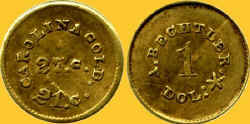This is the Worldwide Numismatics Website!
This is a modest collection of second millennium gold coins of the United States from territorial private mints in the mid-19th Century
Click the thumbnail picture to see a larger version of the picture, then use your browser BACK button to return to the original page you were viewing.
AUGUSTUS BECHTLER - RUTHERFORD, NORTH CAROLINA
$1 - ca1842 - A. BECHTLER
KM-83.1 - 1,75 g - 17,0mm
Gold was discovered in North Carolina in the early 1800s, leading to America'sa first "gold rush." The first gold $1 coins made in the United States were privately minted issues. In 1830, Christopher Bechtler born in Baden, Germany, bought land in Rutherford County, North Carolina. In 1831, he opened a private mint near Rutherfordton responding to the growing public need for reliable assaying and minting of gold by the mining community. The Bechtler mint operated successfully from 1831 to circa 1857 under the direction of Christopher Bechtler, Sr. along with his son Augustus, and nephew Christopher, Jr. The Bechtler mint has the distinction of minting the first gold dollar in America. Most Bechtler coins are stamped C. BECHTLER or A. BECHTLER, along with the weight in grams and the number of carats, or amount of gold in the alloy.The obverse has the weight 27 g(rains) in the centre with CAROLINA GOLD around the top and the fineness 21 c(arat) at the bottom. The reverse has a large 1 in the centre with A. BECHTLER around the top and DOL9lar) at the bottom.
MOFFAT & CO. - SAN FRANCISCO, CALIFORNIA
$5 - 1849 - MOFFAT & CO
KM-037 -
8,36 g - 21,6mm
Gold was discovered in 1848 in California, launching America's second (and greatest "gold rush." John Little Moffat arrived in San Francisco during the summer of 1849. Moffat & Co. started in the gold smelting and assaying business. They starting minting coins in mid-1849 with the $10 coin being first produced. Later they issued the $5 piece, both denominations were struck in 1849 and 1850. They also struck $10 and $20 coins in 1852. Most were issued under contract to the U.S. Assay Office.
This is a Territorial U.S.A. $5 coin that was minted by Moffat & Company in San Francisco California in the style of the national coins. The obverse features a bust of Liberty encircled by 13 stars. The tiara has MOFFAT & CO instead of LIBERTY as on government issued coins. The date 1849 is below the bust. The reverse has a standing eagle with the the legend S.M.V. (Standard Mint Value) CALIFORNIA GOLD. The denomination FIVE DOL. is below the eagle.
KELLOGG & CO. - SAN FRANCISCO, CALIFORNIA
$20 - 1855 - KELLOGG & CO
KM-033 -
33,44 g - 34mm
John Glover Kellogg arrived in San Francisco in late 1849. He first was employed by Moffatt & Co. After leaving Moffatt, local bankers asked Kellogg to strike gold coinage to fill the gap until the new San Francisco Mint came on line. Kellogg issued $20 coins in 1854 in response to these requests. In early 1855, he joined with Augustus Humbert to form a new firm, Kellogg and Humbert, and they continued minting these $20 coins until late in 1855 when the government mint was finally fully operational.
This is a Territorial U.S.A. $20 coin that was minted by Kellogg & Company in San Francisco California in the style of the national coins. The obverse features a bust of Liberty encircled by 13 stars. The tiara has KELLOGG & CO instead of LIBERTY as on government issued coins. The date 1855 is below the bust. The reverse has a heraldic eagle with the the legend SAN FRANCISCO CALIFORNIA. The denomination TWENTY D. is below the eagle.
CLARK, GRUBER & CO. - DENVER, COLORADO
$10 - 1861 - CLARK, GRUBER & CO
KM-070
- 16,72 g
Gold was discovered in Colorado in mid-1858 causing another "gold rush." Austin and Milton Clark, and Emanuel Gruber first set up a concern to purchase raw gold at a discount, then shipping it to the US Mint in Philadelphia for mintage into coins that were badly needed in Colorado. In 1860, they had set up a functional minting facility that struck $2.50, $5, $10, and $20 gold coins. Mintage continued into 1861. A new U.S. Mint was authorized for Denver in 1862. In 1863, the company sold their mint to the U.S. Government.
This is a Territorial U.S.A. $10 coin that was minted by Clark, Gruber & Company in Denver Colorado in the style of the national coins. The obverse features a bust of Liberty encircled by 13 stars. The tiara has PIKES PEAK instead of LIBERTY as on government issued coins. The date 1861 is below the bust. The reverse has a standing eagle with the the legend CLARK GRUBER & CO DENVER. The denomination TEN D. is below the eagle.
If you wish to return to the main page, click here - Main
If you want to return to the home page, please click here - Home
